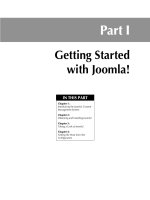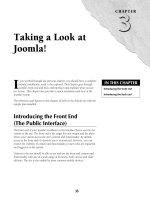Thiết kế web với joomla 1.6(5).x part 2 pptx
Bạn đang xem bản rút gọn của tài liệu. Xem và tải ngay bản đầy đủ của tài liệu tại đây (787.95 KB, 8 trang )
Chapter 1: Introducing the Joomla! Content Management System
7
l
Open source can be vendor agnostic. You are not tied to a single vendor and cannot be
held hostage by that vendor.
l
Open source presents less risk. Studies consistently show that open source development
process produces better code and that many eyes make for more secure applications.
Moreover, when problems are detected, open source produces patches at an extremely fast
rate.
l
Open source is easier to install, configure, and customize.
l
Open source promises more rapid innovation.
If you are still not sure, start small. Roll out an open source solution in a limited role in your firm.
Try it out. Six months from now evaluate the result and decide whether open source is the right
path for you. If you are like many others, you will find that it is not only a viable option, but also
an attractive one!
Discovering Joomla!
Joomla! started life in 2005 as a fork of the already popular Mambo open source content manage-
ment system. The Joomla! community came together around the new project very quickly and
helped create prominence and excitement around the new brand. Over the years, the project has
gone from success to success and has grown to become one of the largest and most active open
source projects.
The features included with the core system include:
l
WYSIWYG Content Editor: Edit articles with the ease of use of a word processor.
l
Content scheduling: Set start and stop dates for the publication of your content.
l
Content archiving: Store old articles for ease of reference.
l
User management: Create users and assign them to groups.
l
Access control: Control the users’ access to content and functionality.
l
Media manager: Upload and organize your media files.
l
Language manager: Add new language packs to enable multi-lingual interfaces for your
site.
l
Banner manager: Upload and run advertisements.
l
Contact manager: Store contact details of your users and enable contact forms for them.
l
Polls: Run polls and surveys on the site.
l
Search: Search the site’s content.
l
Web links management: Create pages containing links to other web sites.
l
Content syndication: Syndicate your content items with RSS feeds.
l
News feed aggregation and display: Bring external RSS content into your site.
Part I: Getting Started with Joomla!
8
l
Integrated help system: View help files from within your admin system.
l
Multiple template management: Add new templates and assign them to the pages of
your site.
l
Cache management: Manage site performance by controlling the caching of information.
l
Integrated FTP: Use the system’s integrated FTP manager to move files to and from your
server.
l
Search engine friendly URLs: Create search engine friendly URLs to make your site more
competitive on the search engines.
Joomla! 1.6
In addition to the core functionalities, Joomla! is extendable. With over 4,000 open source extensions available
for little or no charge, you can customize the site to include the functionalities you need.
Deciding to use Joomla!
Why should you use Joomla? The short answer is that Joomla! provides an easy-to-install option
for creating and managing a full-featured web site. The system is easy to use, affordable, and flexi-
ble enough to grow with you over time.
Joomla’s popularity means that you can find a large number of example sites live on the Web. The sys-
tem supports everything from small marketing sites to large e-commerce sites. Here’s a roundup of
some of the better known companies and brands that use Joomla!
Name URL
Harvard University, Graduate School of Arts and Sciences
/>IHOP Restaurants
/>Nickelodeon
/>United Nations Regional Information Centre
/>U.S. Army Corps of Engineers
Yale University Association of Yale Alumni
/>University of Nebraska
/>Olympus (Australia)
/>Epson - Research & Development
/>Dr. Ruth
Samuel L. Jackson
/>Who uses Joomla!
Chapter 1: Introducing the Joomla! Content Management System
9
Although Joomla! is an excellent solution for many needs, it is not suited to every conceivable use.
There are areas where the system excels, and others that present challenges. If you want to be more
analytical about Joomla, then you should consider the pros and the cons.
Pros
l
Over 10 million downloads: This is a healthy and growing project with a large fan base.
l
Over 4,500 extensions available: The large number of extensions means you can tailor
Joomla’s functionality for your site.
l
Uses the popular LAMP stack: It is easy to find hosting and help.
l
Presentation layer is very easy to work with: You can customize the appearance of the
site to match your brand. You aren’t restricted to creating a “cookie cutter” web site.
l
Decent e-commerce options: If you want to sell products online, Joomla! is perfectly
capable of delivering all the most common e-commerce functionalities as well as providing
usable catalog management.
l
Wide developer support: It’s easy to find help for your Joomla! site. Developers, design-
ers, and other third-party services are readily available.
l
Decent documentation: The online documentation provided by Joomla! is some of the
best in open source. You can also find commercial documentation in a variety of formats.
l
Very active community: An active and dynamic community means that you can get sup-
port in the forums and you can be assured of the ongoing vitality of the project.
l
Affordable development costs: Competition and a common platform make for a wide
range of vendor choices and price points. Given the large number of people providing
Joomla! services, you can probably even find someone in your area.
Cons
l
No workflow: If your site needs to replicate your offline workflow, Joomla! may not be
the answer for you. The system does not include a workflow engine.
l
Limited user hierarchies: The Joomla! 1.5 system includes a limited and fixed hierarchy of
users. If you need complex user permissions, you either should choose Joomla! 1.6, or face
installing extensions to your site to add this functionality. Be sure to examine the third-party
extensions to determine if they will meet your needs in advance of committing to the system.
l
Limited content structure: The Joomla! 1.5 system includes a limited and fixed content
organization structure. If you need to create a site with complex content structures, you
should either choose Joomla! 1.6 or face installing extensions to your site to add this func-
tionality. Be sure to examine the third-party extensions to determine if they will meet your
needs in advance of committing to the system.
l
Can be tough to maintain customized sites: If you need to customize the code of your
site, you have to be careful with upgrades in order to avoid losing your customizations.
So, the greater the amount of customization you need, the greater the amount of work
involved in upgrades.
Part I: Getting Started with Joomla!
10
l
SEO is mixed: Joomla! includes an SEF URLs option, but the default system’s configura-
tion options are quite limited. There are, however, a number of third-party extensions you
can add to the site to improve this.
l
Extensions vary widely in quality: While there are a lot of extensions available for the
system, they are not of equal quality. Do your homework and check extensions carefully
before committing to them.
l
An increasing number of extensions are commercial: The Joomla! core is free of charge,
but a number of extensions for the system are commercial — and some are even
encrypted! This troubling trend is a cause for concern and does erode some of the cost
advantage of the system. Encrypted extensions also destroy your freedom to modify the
code and should be avoided.
The Joomla! open source license
The Joomla! system is released under the GNU General Public License, commonly known as the
GNU GPL. Joomla! is governed by Version 2.0 of the license. The GNU General Public License
grants users four freedoms:
The freedom to run the program for any purpose.
The freedom to study how the program works and adapt it to your needs.
The freedom to redistribute copies so you can help your neighbor.
The freedom to improve the program and release your improvements to the public, so that the
whole community benefits.
As a site owner, this means that the software is free of licensing fees and that you are able to use it
for any purpose or any type of site. The only significant restriction is on your ability to resell the
system; though it is permissible to sell products that include the code, you must release those
products under licensing terms that are consistent with the GNU GPL v.2. This provision essen-
tially takes away the motivation to turn the code into a commercial product because the terms of
the license mean that the person who buys the code can distribute it to the public without paying
you further for that privilege.
The user’s freedom extends to the right to modify the code. You are not only free to use the system
however you see fit, but you are also free to customize the code to suit your needs. Although your
customizations are modifications of the GPL code, the license does not force you to disclose that
modified code to others, unless you decide to release and redistribute the code. In other words,
you cannot be forced to release code you have developed but do not wish to release to the public.
The majority of the extensions available for the Joomla! system are also released under the GNU
GPL. While some of the extensions are commercial, and a few are even encrypted, a growing impe-
tus exists within the Joomla! community to make sure that extensions are fully GPL-compliant and
that the code for the extensions is accessible and can be modified by users.
Chapter 1: Introducing the Joomla! Content Management System
11
The Joomla! architecture
Joomla! is designed to run on the popular and widely available LAMP stack, that is, on Linux with
the Apache web server, the MySQL database, and the PHP programming language.
In broad terms, Joomla! works like this: When a site visitor requests a page by clicking on a link,
Joomla! assembles that page by pulling the contents from the database; it then uses the template
files for guidance in how to present that information on the page. The merged information is then
sent to the user’s browser where it is rendered for the visitor to see.
Unlike other systems that store rendered pages, almost all information in Joomla! is kept in the
database and produced on the visitor’s screen on demand. The text, images, usernames, and pass-
words are all kept in the database. Use of caching can change this to a limited extent, but generally
speaking everything is dynamically generated. When you are editing content in Joomla!, you are
editing information in the database. The Joomla! template files provide the formatting and layout
the site visitors see on their screens. A template is actually a collection of files typically containing a
mix of CSS, PHP, HTML, XML, and image files. If you want to change the underlying layout of the
site’s page, then you need to edit the template files.
Programming languages used
Joomla! is primarily written in PHP, though you will find a number of types of files inside the sys-
tem, including the following:
.css
.html
.ini
.js
.php
.xml
You will also find image files in the following formats:
.gif
.png
.jpg
The database
Joomla! is built to run on the MySQL database. Joomla! 1.5 is compatible with Versions 4.1 and
later of MySQL. Joomla! 1.6 requires version 5.0.4 and later.
Part I: Getting Started with Joomla!
12
Joomla! is an example of a community-driven open source project. This means that unlike corpo-
rate- sponsored projects, Joomla! is the work of a loosely affiliated group of individuals working
together as a community. It is, in other words, a volunteer effort.
Finding out how the community works
Joomla!, like many of the larger community-backed projects, is supported by a foundation. In the
case of Joomla! the foundation is a not-for-profit organization named Open Source Matters. The
foundation holds the intellectual property rights to the brand name and related assets and provides
legal shelter for the project. The foundation accepts donations of cash and services. The donations
go to cover the basic overhead and operating costs such as for the servers, the hosting infrastruc-
ture, and promotional expenses. People are not directly paid to work on Joomla!
Open Source systems like Joomla! are offered free of charge for users. Often, people ask how this is
possible. How is it that they can afford to give something valuable away for free? That is a complex
question and in the case of a community-driven Open Source project, the answer is not always
obvious. Community members work for free largely out of a desire for recognition, status, and
access to expertise. Some are even more idealistic and participate for the pleasure of being part of
something bigger than themselves and to feel like they have given something back to a group that
has helped them in some fashion. The Joomla! Team is divided into a set of Working Groups that
handle the following responsibilities:
l
Development: Develops and maintains the Joomla! codeset.
l
Documentation: Handles the developer and user documentation and maintains the help
site.
The Joomla! team maintains a number of official sites. Some sites are informational in nature, others
provide a way to distribute the code, others help promote and market Joomla!
Name URL
Joomla! (main site)
/>JoomlaCode
/>Joomla! Developer Site
/>Joomla! Extensions Directory
/>Joomla! Documentation
/>Joomla! Forums
/>Official Joomla! sites
Chapter 1: Introducing the Joomla! Content Management System
13
l
Sites and infrastructure: Maintains and moderates the forums and takes care of the vari-
ous official sites.
l
Translation: Coordinates translation of the interfaces as well as helping produce official
announcements in a variety of languages.
l
Foundation: Handles the more administrative matters related to the project, including
marketing, events, and fundraising.
Participating in the community
Volunteers are the lifeblood of Joomla! If you are inclined to get involved with the project, do so.
The easiest way to start is by registering on the Joomla! forums and to contribute by helping others
in the forums. Many users come to the forums with very basic questions; others with more com-
plex technical issues. The forums always need people who are willing to take the time to answer
these questions and help others work their way through problems.
After you have participated in the forums for a while, you will be more familiar with the team
members and how things in general work. If you want to do more, you can then approach a team
member or the leader of a working group and ask to become involved on a more official level.
Open source projects that are the size and scope of Joomla! need all sorts of people. Don’t worry
about whether you have sufficient technical skills or the right type of knowledge. The most impor-
tant requirements are a willingness to donate your time and a sincere desire to help others. There
are opportunities for everyone who is interested in helping.
Summary
In this introductory chapter, we have taken a look at the basics of Joomla! and open source. You
learned the following:
l
The advantages of using open source
l
The pros and cons of using Joomla!
l
How Joomla! works
l
The terms of the Joomla! license
l
How to get involved in the Joomla! community









